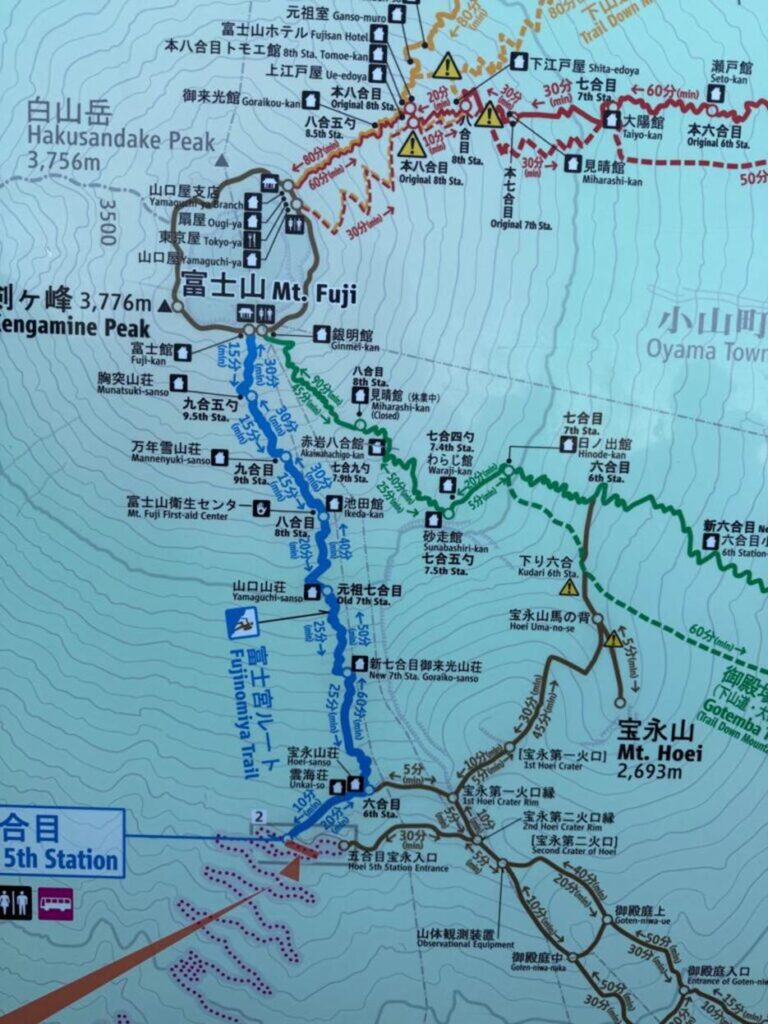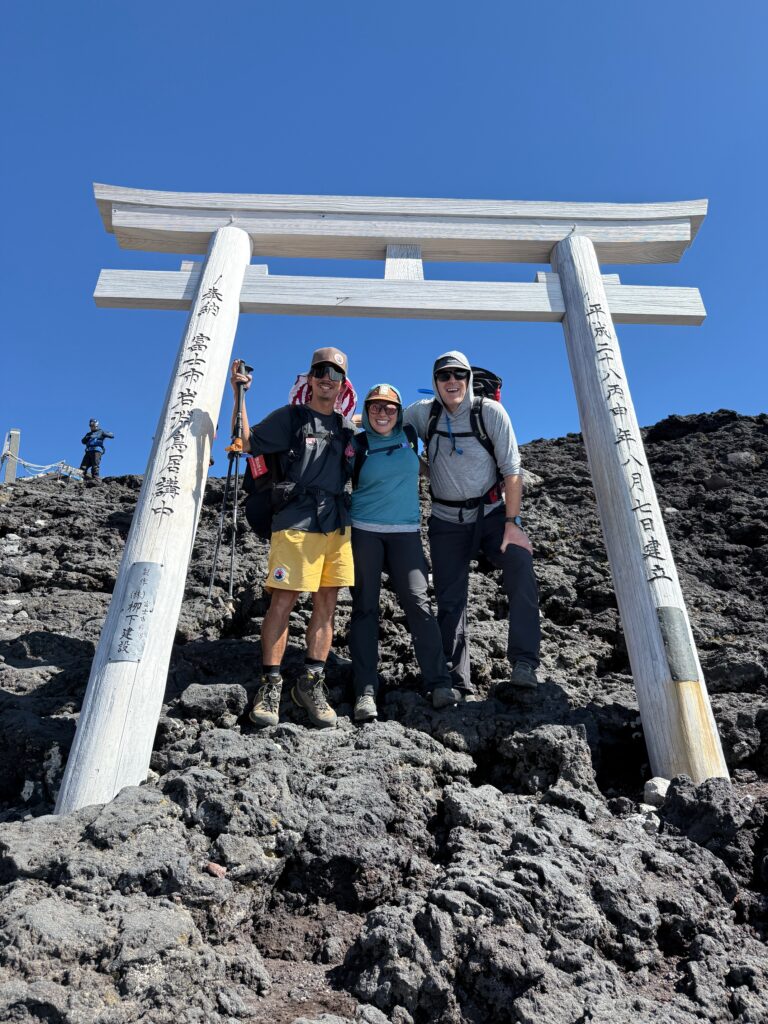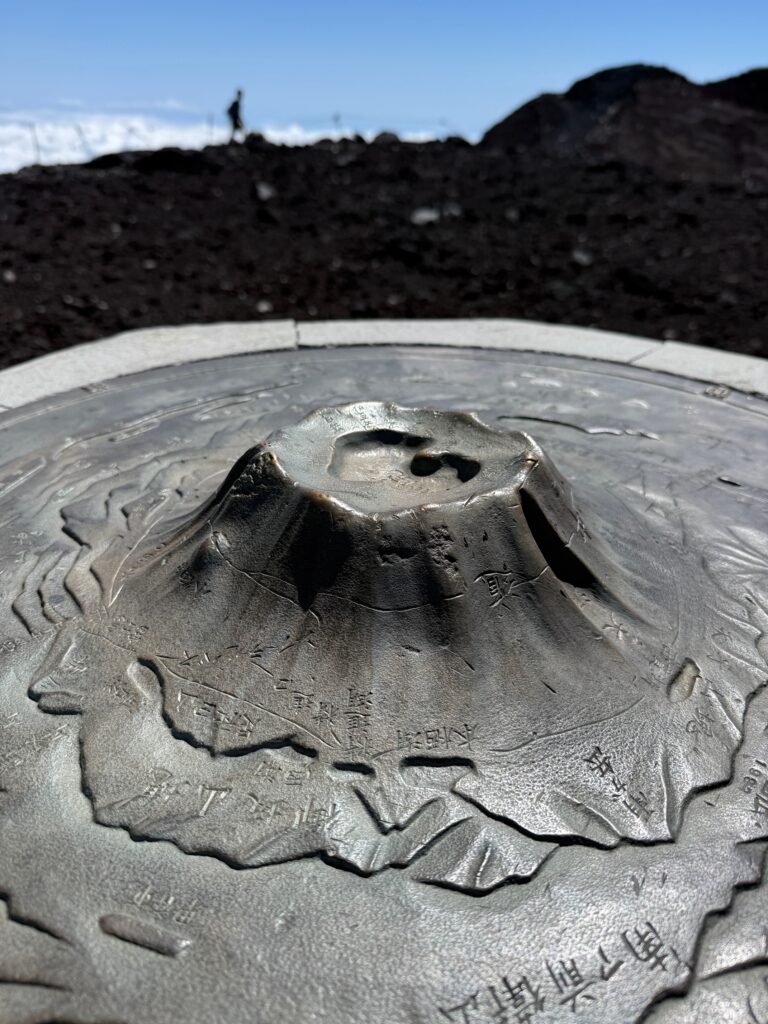Mount Fuji, standing proudly at 12,388 feet (3,776m), is Japan’s highest and most iconic peak. Growing up, I often saw its perfectly symmetrical cone of Fuji on branded items. When I used to get my pictures developed, the company was Fujifilm so the mountain was etched in my imagination long before I ever set eyes on it. Its image seemed to symbolize adventure and beauty. In fact, when I first saw Cotopaxi in Ecuador, its striking resemblance immediately made me think of Mount Fuji.
I had always dreamed of climbing Mount Fuji, but with so many other major peaks around the world demanding attention, this iconic Japanese mountain was placed on the back burner for years. Since a Mount Fuji climb can be completed in just 2 days, I wanted to make the journey even more rewarding by combining it with other trekking options in Japan.
That’s why we created a unique itinerary that pairs the classic Mount Fuji ascent with some of the best trekking routes in Japan, offering a richer and more diverse adventure for trekkers.

Climbing Mount Fuji
Our starting elevation on Mount Fuji is at 7,874 feet (2,400m) and we like to hike up to 10,827 feet (3,300m)to stay the night and ascend early in the morning to the summit at 12,389 feet (3,776m). We then return to the refuge, back up and go all the way back down to the starting point.
Even though accommodation on Mount Fuji is extremely basic, I think if It worth spending the night on the mountain to aid acclimatization, get some rest and split up the steep descent. Hitting the summit and crater hike for the magical sunrise view across Japan will be worth the effort.

Our Extended Mount Fuji 8-Day Itinerary
Climbing Mount Fuji is a once-in-a-lifetime adventure, but we’ve taken it one step further by creating a unique 8-day itinerary that goes far beyond the standard summit hike. Our carefully crafted journey combines Japan’s two highest volcanoes—majestic Mount Fuji and sacred Mount Ontake—into one extraordinary experience.
Along the way, you’ll explore hidden trails, immerse yourself in Japanese culture, and even trek sections of the famous Nakasendo trail, once traveled by samurai and merchants centuries ago. This isn’t just a climb—it’s a deep dive into the landscapes, history, and traditions that make Japan so special.
With our expert team, you won’t just stand on top of Japan’s most iconic peaks—you’ll discover remote paths most travelers never see, enjoy authentic cultural encounters, and move at a steady, safe pace designed for real adventure. By blending two legendary volcanoes with off-the-beaten-path trails, we’ve created a one-of-a-kind expedition that balances challenge, beauty, and culture.
If you want more than just a quick climb of Fuji, this itinerary delivers a rich, unforgettable journey through Japan’s heart and high mountains.
Our Preferred Route on Mount Fuji
Join us for a 2-day Mount Fuji climb via the Fujinomiya Route, the perfect way to experience Japan’s most iconic peak. There are four main routes on Mount Fuji, and we prefer the Mount Fuji tour via the Fujinomiya Route because it offers a more direct ascent, fewer crowds, and excellent access for a private guided climb.
With our experienced English-speaking guide, you’ll trek through stunning volcanic landscapes, stay overnight in a mountain hut at 3,300m, and reach the summit in time for the unforgettable Mount Fuji sunrise experience.
Whether you’re searching for the best time to climb Mount Fuji. A detailed 8-day Mount Fuji itinerary, or a safe and supported guided Fuji climb. This private tour delivers the most authentic and rewarding way to trek in Japan and stand on the highest point in Japan.
Climb Mount Fuji on a Private 2-Day Tour
Join us for a 2-day Mount Fuji climb via the Fujinomiya Route, the perfect way to experience Japan’s most iconic peak. Our private Mount Fuji tour is designed to help you escape the crowds while enjoying the guidance of an experienced, English-speaking professional. You’ll hike through stunning volcanic landscapes, rest overnight in a traditional mountain hut at 3,300m, and reach the summit in time for the breathtaking Mount Fuji sunrise experience.
Whether you’re looking for the best time to climb Mount Fuji, a detailed Mt. Fuji 2-day itinerary, or a fully supported guided Fuji climb, this tour provides a safe, cultural, and unforgettable adventure. Combining local knowledge, authentic Japanese meals, and expert pacing at altitude, our team ensures you not only reach the top but enjoy the journey every step of the way.

What’s Included
Private, locally guided climb to the summit of Mount Fuji via two unique trails and lesser-known routes. Door-to-door shuttle service with private vehicle pick-up and drop-off from Tokyo, Hakone, or the Mt. Fuji area. Experienced, English-speaking guide dedicated to your private group. One night’s accommodation at Akaiwa Hachigo mountain hut 10,827feet (3,300m).
Day 1 – Arrival & Ascent to Mountain Hut (3,300m)
Custom pick-up between 6:30–8:30 am (Tokyo, Hakone, or Mt. Fuji area).
Drive to the Fujinomiya 5th Station (2,400m).
Begin ascent via the Fujinomiya trail, arriving at Akaiwa Hachigo Hut (3,300m).
Enjoy a hot dinner of traditional Japanese curry rice before resting.
Day 2 – Summit Sunrise & Descent
Pre-dawn start: Ascend with headlamps to reach the summit in 2 hours. Watch the sunrise from Japan’s highest point 12,388 feet (3,776m). Optional crater walk, weather permitting. Hot breakfast at the hut, then descend to the Fujinomiya 5th Station. Private transfer back to your accommodation.

Food & Snacks
Meals at altitude are part of the adventure. The hut serves all-you-can-eat curry rice made with homegrown vegetables—a hearty favorite among climbers. After your summit, you’ll enjoy a traditional Japanese breakfast of eggs, ham, rice, and miso soup.
Included: Dinner (Day 1) and Breakfast (Day 2).
Not Included: Two lunches (Day 1 and Day 2). You may purchase meals at mountain huts along the trail (JPY800–1,500) or bring your own packed lunches.
Dietary Needs: While huts do not offer vegetarian options, our guides can carry vegetarian or vegan curry packs if requested in advance.

Accommodation – Mountain Hut at 3,300m
You’ll stay at Akaiwa Hachigo Hut, located at the 8th Station of Mount Fuji. Built as traditional alpine shelters, huts offer a unique cultural experience with dorm-style sleeping arrangements. Sleeping area includes a bunk, bedding, sleeping bag, and pillow.
From summer 2021, each climber has one tatami mat’s worth of space. You will be staying in close quarters. Ear plugs are highly recommended. Expect camaraderie and cultural immersion—this is not luxury, but it’s authentic Japan.
Fitness and Preparation
Mount Fuji’s summit (3,776m / 12,389ft) is high enough that some climbers experience altitude-related symptoms such as shortness of breath, nausea, or headaches. Good physical fitness, proper pacing, and hydration help minimize these effects.
Check our our Training advice for Climbing Mount Fuji and learn how to prepare physically and mentally for the climb.
Gear & Rentals
Proper equipment is essential for a safe and enjoyable climb. Please review our Mount Fuji gear list to ensure you are fully prepared. If you don’t have all the gear, we offer rental packages—from clothing layers to trekking poles—so you can arrive ready without the stress of buying new equipment.

Why Choose This Tour?
Private & exclusive – escape the crowds and trek a route few experience. Cultural immersion – stay in a traditional hut and enjoy authentic Japanese meals. Professional guidance – with years of experience on Mount Fuji, our team ensures your climb is safe, well-paced, and memorable.
Accommodation on Mount Fuji
There are a number of stations with basic accommodation across it slopes and we recommend the Fujinomiya Route. This private route has less people, the best scenery on offer and offers the best experience for this two day climb. Once the hut closed the first week in September, we will have to pick a different route for later season climbs.
Who is the Fuji Climb for?
Climbing Mount Fuji is achievable for a wide range of people, but it’s not a casual walk in the park. The trek is best suited for those with a reasonable level of fitness, some hiking experience, and the determination to keep moving at a steady pace.
While technical mountaineering skills are not required, the steep trails, long switchbacks, and thin air near the summit can be physically demanding, especially on the overnight push to catch sunrise at the top. Families with older children, adventurous travelers, and first-time high-altitude hikers often choose Fuji as a rewarding challenge, but preparation and the right mindset are essential.
If you are comfortable walking uphill for several hours, have trained with hikes or long walks, and are eager to experience Japan’s most iconic peak, the Fuji climb can be an unforgettable adventure.

Where is Mount Fuji?
Mount Fuji is located on Honshu Island, Japan, about 100 kilometers (62 miles) southwest of Tokyo. It sits on the border between Shizuoka Prefecture and Yamanashi Prefecture, and is the country’s highest peak at 3,776 meters (12,389 feet). Because of its proximity to Tokyo and its iconic symmetrical cone shape, Mount Fuji is not only a UNESCO World Heritage Site but also one of the most visited and photographed mountains in the world.
The Best Months for trekking Mount Fuji
The official climbing season for Mount Fuji runs from early July to early September, when the mountain is mostly free of snow, the trails are open, and the mountain huts are operating. During this short summer window, the weather is more stable, daylight hours are long, and support facilities make the climb accessible to thousands of trekkers each day.
July often sees fewer crowds, especially before Japan’s school holidays begin, while August is the busiest month with both local and international climbers aiming for the summit.
Early September can bring fewer people on the trails, but it also carries a slightly higher risk of unpredictable weather. Outside of this official season, conditions on Fuji can be extremely dangerous with snow, ice, and strong winds, and climbing is generally discouraged unless you are an experienced mountaineer with technical gear. For most trekkers, mid-July to early September offers the best balance of safety, access, and atmosphere on Japan’s highest peak.
What sights Will You See?
Climbing Mount Fuji is more than just reaching the summit—it’s a journey through dramatic landscapes and cultural landmarks. At the base, you’ll pass through lush forests known as the Aokigahara Jukai, often called the “Sea of Trees.”
As you ascend, the vegetation gradually thins, giving way to volcanic rock and panoramic views over the surrounding Fuji Five Lakes and, on clear days, even the distant Japanese Alps. Along the trails, you’ll encounter shrines, torii gates, and stone markers, reminders of Fuji’s deep spiritual significance in Japanese culture.
Reaching the crater rim at the summit offers a breathtaking perspective into the vast volcanic crater, and if you climb overnight, you’ll be rewarded with the iconic Goraiko sunrise—a fiery spectacle as the sun breaks over the horizon, illuminating the clouds below.
On especially clear days, you may even catch sight of Tokyo’s skyline and Sagami Bay in the distance, making the climb a truly unforgettable visual experience.
Is Mount Fuji an Easy Ascent?
While Mount Fuji does not require technical climbing skills, it should not be underestimated. The trails are well-marked and maintained, making the mountain accessible to first-time trekkers, but the ascent is physically demanding.
Climbers face long, steep switchbacks, loose volcanic gravel, and the challenge of thin air above 9,800 feet (3,000 meters). The biggest hurdles for many are the altitude, the overnight summit push in cold, dark conditions, and the mental stamina required to keep moving steadily upward.
That said, with proper preparation, pacing, and the right gear, thousands of people of all ages successfully reach the summit each year. Fuji is often described as “easy to attempt, but harder than expected to finish,” making it a rewarding challenge for anyone willing to put in the effort.
How can I sign up
Visit our upcoming trips page on the website to find a trek you want to join. Contact us and we will email you our booking forms to fill out. Once you decide to sign up we will send you our trip dossier with itemized kit list and more details about the trip. From there we will look for a deposit and then final payment is needed 60 days before the start of the trip. Ian Taylor Trekking offers pre-trip support (gear advice, training, etc.) so you can get ready ahead of time.
What Other Areas of Japan are good for Trekking
What do you Need to Bring With you?
Good hiking gear. The temperature on the summit will be between 20F (-6c) and 32 F (0c) degrees. It is extremely important that you bring all the necessary gear to be prepared for hot, cold, rain and sun. You will need proper rain gear on Mount Fuji. Please see our Kit list of required equipment here.
Meals/snacks/drinks. We will be providing dinner and breakfast on your tour. You will be on your own for bringing or buying two lunches, snacks and water. These items are available to purchase on Fuji during your climb.
Toilet money. Each use of the toilet costs ¥200- ¥300, so you’ll need to bring money with you for this purpose. You don’t have to bring exact change. Souvenir money. Mountain huts sell fun things you might want to take home with you.
Baggage storage
On our trips you can leave your duffel bag at the hotel before going on the climb. You can pick this bag up when you return off the mountain. Some items not needed for the summit can stay at the hut so you can carry less weight.
Unfortunately we cannot accommodate luggage storage on the mountain. As we can’t guarantee space for this in our private vehicle. Luggage transfer to your next destination. Very cheap and efficient, mailing your luggage to your next destination is a great option. You can mail your luggage through your hotel.
Other Things you Should Know
Please prepare yourself for the mountain hut experience on Mount Fuji. While significantly better than a tent (and boasting such features as cold beer and hot food on demand), the accommodations are primitive. And no, the mountain huts do not grant special space or accommodations no matter what financial incentive you might offer. This is a unique cultural experience, embrace it 🙂
Got questions? We’ve got lots of answers. Review our Top Tips for climbing Mount Fuji and our Frequently Asked Questions page here.
